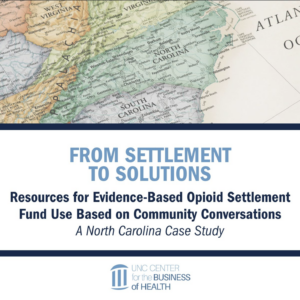News & Stories
Creating an opioid epidemic playbook

A groundbreaking online resource hub created by the UNC Center for the Business of Health (CBOH) captures the depth and complexity of the opioid epidemic’s devastating grip on North Carolina.
The resource outlines evidence-based strategies to help the state and localities strategically utilize the billions of dollars in settlement funds designated to combat substance use disorder and support opioid abatement in communities.
The resource “Community Conversations” on the CBOH’s new opioid project website compiles key takeaways from a years-long research project based on extensive conversations with North Carolinians living in diverse urban and rural areas of the state. It offers far-reaching guidance for local governments and communities across the U.S. now deciding how best to use the funds from legal settlements with opioid distributors and manufacturers.
The adaptable playbook is the result of a two-year partnership between the CBOH and Acadia Healthcare. North Carolina communities are set to receive nearly $1.5 billion in settlement funds through 2038. Local governments in North Carolina will receive 85% of the settlement funds, with the bulk of the payout scheduled through 2026, and the state government will receive 15%. National settlements total $56 billion.
“Part of the CBOH’s mission is to catalyze collaboration and convene important stakeholders to solve significant challenges in healthcare,” says Zoey Kernodle, CBOH director. “This project exemplifies how we can do that here in North Carolina, demonstrating the powerful impact of public-private partnerships in addressing public health issues. Not only does this work have a meaningful impact here at home, but it also creates a blueprint for others to follow.”

The Center for the Business of Health’s opioid playbook resource follows two years of research across North Carolina.
The CBOH worked on the project with several departments and units at UNC, including economic development center NCGrowth, part of the Kenan Institute of Private Enterprise at UNC Kenan-Flagler, and the UNC Department of Economics, leveraging their health economics expertise. Additionally, research conducted by business students in the STAR (Student Teams Achieve Results) program helped develop strategies and recommendations to address access-related barriers to fighting the epidemic in the state’s rural areas.
The playbook outlines various community opioid indications to show the diversity in how the crisis is impacting North Carolina. Users can explore county-level data visualizations on various metrics, including emergency department visits, deaths, distance to medication-assisted treatment centers and hospitalizations.
These visualizations provide a clear picture of how the opioid crisis is affecting different North Carolina communities, from Pamlico County near the Outer Banks to Winston-Salem in Forsyth County to a group of western counties in the Appalachians — all of which CBOH engaged with during this project to gain local context and perspective on settlement fund use.
“There are great resources out there that track where settlement funds are going and a constellation of tools, calculators and best practice resources to help address this challenge,” says Kernodle. “We’ve put all of the top resources in one place along with our own community-based research, making it much easier for communities to make informed decisions.”
The website delves into a range of unique challenges that stakeholders have identified, including inequities in access to healthcare and funding distribution, varying stigmas attached to specific treatment methods, social barriers and gaps in education about the crisis and settlement funds.
It thoroughly outlines emerging best practices across the state to address the crisis, such as innovative treatments, partnerships between healthcare organizations and local governments, county consortium planning models and transparent government communication with residents. Additionally, it compiles specific requests from communities to help manage and mitigate the crisis, including more resource hubs like the CBOH’s, grant assistance tools and increased collaborations with higher-education researchers and health-service providers.
“A major takeaway from our local conversations was there is no ‘one-size-fits-all’ policy or decision-making approach to the settlement funds that will work best for everyone. It all comes down to local context and perspective,” says Joshua Barrett, CBOH associate director. “If you look at a map of the 100 North Carolina counties, you see examples of neighboring counties funding and prioritizing completely different strategies with their settlement funds. That is why when we first started to develop this website, we quickly moved from showcasing our own insights learned from engaging communities to aggregating all the best tools and resources we could find and compiling them in one place. The more resources communities have access to the better it is for addressing these issues.”
The CBOH team conducted extensive literature reviews on commonly chosen abatement strategies, aggregated useful resources for a variety of stakeholders and developed a cost-effectiveness calculator for naloxone (Narcan) distribution.
The continued development of resource hubs such as this are necessary as the opioid crisis continues to harm communities across the nation.
The Centers for Disease Control and Prevention estimates that between 1999 and 2021, approximately 645,000 people died from a drug overdose involving an opioid, including prescription and illicit opioids. In 2022, more than 75% of an estimated 107,000 drug overdose deaths in the U.S. involved an opioid.
“A major takeaway from our local conversations was there is no ‘one-size-fits-all’ policy or decision-making approach to the settlement funds that will work best for everyone.” — Joshua Barrett, CBOH associate director
In North Carolina, overdose deaths rose 40% between 2019 and 2020 and increased 22% between 2020 and 2021, according to the North Carolina Department of Health and Human Services. In 2021, over 77% of overdose deaths in the state likely involved fentanyl.
“Every community is different and will take their own particularities into consideration when deciding how best to use the funds. The communities know their needs best,” says Kernodle. “However, by engaging people on the ground and conducting more intensive research on abatement strategies, trends begin to emerge where communities can see themselves in other communities with similar compositions. This connecting-the-dots work can lead to a much more manageable and impactful process for decision makers who want high impact outcomes.”